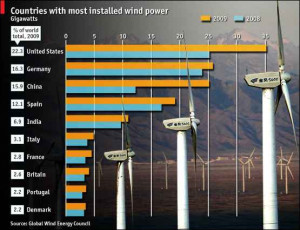Jellyfish’s inventor Chad Maglaques’s vision on his micro-turbine invention and does it fit with Google’s current perception on Zeitgeist?
Chad Maglaques’s micro-turbine invention is only 3 foot high and can be mounted onto any rooftop. The difference to other small scale wind turbines, the Jellyfish wind turbine can be plugged directly into a standard residential household electrical socket making it extremely user friendly. The turbine is controlled by a variable-speed motor which creates a current that is compatible with the grid and can produce up to 40 kilo watts.
Maglaque’s vision is that the Jellyfish wind turbine will become a standard day to day piece of household equipment which can be purchased at any local hardware store, just like a fridge or a coffee maker from your electrical appliance shop. With the simple combination of accessibility, affordability and very easy assembly, Maglaque hopes that we will eventually see this little but amazing invention on every residential rooftop. This level of ubiquity is of course the hope of every inventor one might say but Maglaque’s bigger vision is to bring a dramatic and large scale change to our relationship with energy production. It would mean the end for consumers switching on energy mindlessly, and the end of paying high utility bills with resentment at the end of each month. Instead, personal wind power production will allow us to generate energy where needed and involving us in the process instead of just delivering uncontrollable results.
In contrast to other personal renewable energy tools, The Jellyfish windmill could help us to create energy in order to drive down our ownenergy bills, sell it back to the local electricity grid, and hopefully help us to witness the creation of a better, more reliable grid system through our own, personal investment in the utility.
One of Maglaque’s shared vision for the Jellyfish is to help and enable district wind energy co-operations. ‘Just imagine if hundred of thousands of personal wind turbines could all create energy for the grid’ Maglaque says. He is convinced that neighbours could join together to work together with nationwide power utilities.
“Say you’ve got 10,000 units in one city. If you connect those units on a server, and generate power together — managing and regulating that power — you are in a position to work with power utilities,” Maglaque says. “This is good for customers because it provides a marginal return, and utilities like this as well because a: you have on demand power, and b: you free up funds to be allocated to the grid network that needs expansion and repair.”
Maglaques’s other big hope is also for the Jellyfish to help people in developing countries to overcome the excessive use of dirty energy and convert more quickly into renewable energy production.
Now, does Maglaque’s vision fit the bill on Google’s view on Zeitgeist? We would think so. The reasons for this you might ask yourself? The answer is simple: Google’s contest management decided to let the public only vote on 100 ‘Google’ selected entrants and will then select the final five winners themselves who will receive the $10m contest price and taking into consideration that Google’s management is currently evaluating to completely overhaul and re-fit Google’s huge server mainframe systems to chipmaker Intel’s new energy saving ‘Nehalem’ processor, (to achieve potential savings of up to $80m per annum on Google’s electricity bill), one would expect that Chad Maglaque’s vision of the Jellyfish’s success would also perfectly fit the bill of Google’s current perception of ‘Zeitgeist’. These facts might put Chad’s little Jellyfish invention in a position of having ‘that little extra advantage’ over all the other contest entries…… and seeing Chad’s Jellyfish micro-turbine being one of the last fiver winners walking away with the price might not be coming as a big surprise at all….only time will tell.
Related Article : Building My Own Small Wind Turbine Saves Money Every Day
Buy
Wind Systems
for less then $1,000!





In times of low wind, up systems, such as conventional power stations, must take up any shortfall. Electrical Appliance
I run a charter school with 1,200 students in Florida. We are looking for roof mounted smaller wind turbines which could reduce our power costs and may be interested in your product as it comes to market. Please keep us on your mailing list.
I’m just a home owner, and love you idea, I want one now, along with solar panels on the roof. It is a great idea. Hope that you can move ahead and get funding and manufacturing for you great idea. EGD
hi
can i get the private chad maglaques’s email ?
the contact for the jellyfish manufacturer is: Clarian Technologies and they can be reached by either email on info@clariantechnologies.com or by phone on 206-604-8505
Hi I am from Malaysia and keen on the development update of the Jellyfish Wind Turbine. The solution and relative affordable cost is good news that can help a lot of people in the world including mother earth.
Please send me email contact of Clarian Technologies and kindly update me on any developments.
Thanks in advance…
Come on! No data sheets – no power curves – nothing except smoke being blown.
A hundred similar types don’t work but by magic and wishes this one will?
Let them provide data and testing by a government agency – then start to try to raise a fuss. İt won’t happen because the thing won’t be useful to the public.
Plug the output into a wall socket and backfeed the house electrical system? Sure! That would be against code because it is dangerous with the potential to kill someone.